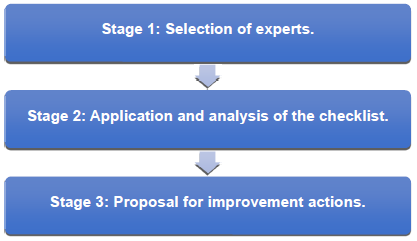
Figure Nº 1: Methodology to evaluate the project and knowledge management in a university.
Source: Own Elaboration
_____________________________________________________________________________________________________________________________
Visión de futuro
REVISTA CIENTIFICA
ISSN 1668 - 8708 VERSION EN LINEA
URL DE LA REVISTA: http://visiondefuturo.fce.unam.edu.ar/index.php/visiondefuturo/index
E-mail: revistacientifica@fce.unam.edu.ar
_____________________________________________________________________________________________________________________________________________
AÑO 17, VOLUMEN 24 N° 1, ENERO - JUNIO 2020
URL DEL DOCUMENTO: http://visiondefuturo.fce.unam.edu.ar/index.php/visiondefuturo/issue/view/17
Los trabajos publicados en esta revista están bajo la licencia Creative Commons Atribución-NoComercial 2.5 Argentina
METHODOLOGY TO EVALUATE PROJECT MANAGEMENT AND KNOWLEDGE IN A UNIVERSITY
Sadilet Díaz Pérez; Nora Unger Marbán; Daniel Alfonso Robaina
____________________________________________________________________________________________________________________________________________
Methodology to evaluate project management and knowledge in a university
(*)Sadilet Díaz Pérez; (**)Nora Unger Marbán; (***)Daniel Alfonso Robaina
(*)Faculty of Industrial Engineering Technological University of Habana
Marianao, La Habana, Cuba
sdiazp@tesla.cujae.edu.cu
(**)Faculty of Industrial Engineering Technological University ofHabana
Marianao, La Habana, Cuba
nora.unger@heber-biotec.com
(***)Faculty of Industrial Engineering
Technological University of Habana
Marianao, La Habana, Cuba
dalfonso@ind.cujae.edu.cu
Reception Date: 02/04/2019 – Approval Date: 04/15/2019
ABSTRACT
The main objective of the present work is to: Establish a methodology to evaluate project and knowledge management at the José Antonio Echeverría University of Technology in Havana. For what is formulated as a problem to be solved: How to contribute in CUJAE to project management and knowledge approaches? The tools used to fulfill the purpose of this study were: Review of the documentation, Interviews, Diagnostic Methodology, Checklist, Diagram of Relations and Alpha of Cronbach. Making use of the above tools, it was obtained as a result that the variable on which the main actions in the university should be directed is on Strategic Planning; arriving at the following conclusions: A methodology was elaborated and partially implemented in order to evaluate the projects and knowledge management in the Technological University of Havana, with which deficiencies were detected in the variables analyzed and a priority order was proposed to eradicate those deficiencies.
KEY WORDS: Project Management; Knowledge Management; Strategic Planning.
INTRODUCTION
Knowledge management is a tool that allows implementing the competitive strategy of an organization, governing a process that consists of: Identify, acquire, store, disseminate, share, use and update tacit and explicit knowledge, thus becoming a learning tool and in a catalyst for innovation, which combined with an adequate business strategy provides a competitive advantage (Hernández, Vega, y Prado, 2017).
The Universities are the educational institutions that have in their hands the development of the country. The expressed adduces that universities are based on knowledge to be able to meet the challenges set forth in the Law, vitalizing and promoting society (Jiménez, Cornelio, y Vera, 2017).
The research projects developed in the university context require proper administration and supervision. In an investigation carried out by Durán and others (2015) there is evidence of the need to standardize the management of projects in the university setting (Doñe, Canelon, Barbosa, y Herrera, 2018).
The Technological University of Havana José Antonio Echeverría, CUJAE, place where this research work was carried out, is the largest university of technical sciences in Cuba, which was founded in order to interact actively in the development of the economic and social activities of the country through the continuous training of professional engineers linked to society and scientific research, with the aim of achieving benefits for Cuban society. That is why the university needs to develop an integrated strategic management approach that allows it to maintain itself over the years transmitting knowledge, which is taxed on projects that generate significant results both for society and for the university itself.
From this reasoning, and bearing in mind the contribution that universities have in the scientific production of a country, it is necessary to propose management techniques that improve the contribution of universities to society. (Jiménez et al., 2017).
Currently there are international rankings where universities are positioned taking into account their results, among which is the Scimago ranking. In this the universities are evaluated by different indicators. In 2010, the CUJAE had a low performance of the aforementioned indicators; Therefore, a Reference Model was created in 2011, where indicators are expressed with goals to be achieved at the level of international rankings. Analysis carried out up to 2015 show that 100% compliance with the research and post-graduate indicators of the Reference Model is not achieved, since only the indicators are met: National and International Awards, Books and book chapters, Postgraduate programs that pay taxes to research lines, Self-evaluations and improvement plans; and the remaining 12 indicators are broken. This resulted in the university moving from position 223 in 2014, to 227 in 2015 in the Latin American ranking of Scimago.
In addition, studies conducted in 2012 show that there is a generational gap that will disappear in the future, since 54% is concentrated in more experienced teachers (over 50 years old), while 30% are teachers with less experience, ages between 23 and 35 years, and only 16% of teachers between ages of 36 to 50 years, that is to say that in some years there will be a smaller number of professors with more experience.
Taking into account the above, it can be stated that the field of action is the Science, Innovation and Postgraduate process of the university; defining as problematic situation the following:
-Insufficient scientific production of the University, taking into account the Latin American standards.
-Existence of a generation gap that contributes to a knowledge gap that in the future will not exist, which results in the decrease of more experienced teachers.
-Insufficient project management for the scientific results of the University.
For what is formulated as a problem to be solved: How to contribute in the CUJAE to the project and knowledge management approaches?
To give solution to the problems raised above, the general objective pursued by this work is: Establish a methodology to evaluate project and knowledge management at the Technological University of Havana José Antonio Echeverría. In order to achieve this objective, the following specific objectives were set:
1.Prepare the theoretical-methodological framework on Project Management and Knowledge Management in the university environment.
2.Diagnose, through the process of Sciences, Innovation and Postgraduate, project management and knowledge in the Technological University of Havana José Antonio Echeverría, CUJAE.
3.Design a methodology to evaluate the project and knowledge management in the Technological University of Havana José Antonio Echeverría.
4.Partial application of the methodology to evaluate the project and knowledge management in the Technological University of Havana José Antonio Echeverría.
DEVELOPMENT
Design of a methodology to evaluate project and knowledge management at the Technological University of Havana José Antonio Echeverría
Project management and knowledge management are disciplines that have been gaining strength as companies and institutions have faced the difficult challenges of competing in a global world, where they need to be increasingly competitive and efficient. Many authors such as (Anchundia, 2015, Duncan, 1996, González, 2013, Herrera, 2014, León, 2013, Rivera, 2013, Sánchez, 2000, Singh, 2016, Wallace, 2014) have spent their time writing about these , because they are very important disciplines for a university because it helps to manage strategies, solve problems quickly, disseminate best practices, incorporate better knowledge in products and services, generate new ideas, increase opportunities for innovation, as well as determine success or failure of its processes. That is why in this work a methodology was developed that allows to evaluate said managements in university environment (See Fig. 1).

Figure Nº 1: Methodology to evaluate the project and knowledge management in a university.
Source: Own Elaboration
Stage 1: Selection of experts
In this first stage an analysis is carried out to select those people who are considered knowledgeable experts of the university, where the majority must be heads of different research groups and others that are linked to the processes under study, capable of giving an assessment on the behavior of project management and knowledge.
For the final selection of experts, it is necessary to determine the Expert Level (NE), which depends on the variables Experience (Ex) and Study (Es), where the first refers to the years of practice and the second to the different research work on the subject. To determine in the NE the following formula is used:
NE= 0.6*Ex + 0.4*Es
Where:
The values of the Ex variable are shown in the following table:
Table N° 1. Ex Values
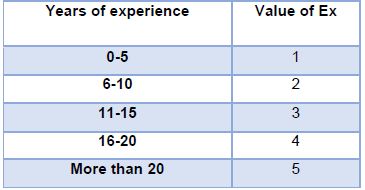
Source: Own Elaboration
The values of the Es variable are shown in the following table:
Table N° 2. Es Values
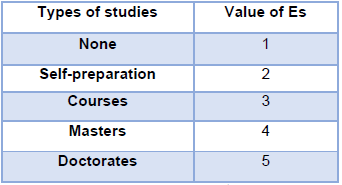
Source: Own Elaboration
Finally, those with an NE ≥ 3 are selected.
Stage 2: Application and analysis of the checklist
In this stage, the checklist proposed in the previous section is applied to the experts of the university under study, selected in the previous stage. Validation of the list is also carried out using the Cronbach's Alpha method and the relationship diagram of the project management and knowledge management variables is used to determine on which variables the actions should be mainly directed, that is, the variables are going to be prioritized taking into account those that obtained results with less performance in the application of the checklist and the cause-effect relationships obtained in the relationship diagram.
Stage 3: Proposal for improvement actions
A plan of improvement actions is proposed based on the deficiencies found with the application of the checklist. The proposed actions must be structured according to the proposed order of the variables in the previous stage. In addition, a responsible party, participants, start and end date, and resources must be identified for each improvement action.
As a main tool of the proposed methodology, a proposal for a checklist consisting of 27 questions was elaborated. It was carried out on the basis of 9 identified variables that characterize the management of projects and knowledge in a university. Next, a detailed description of them is shown.
Variables that intervene in project and knowledge management:
Resources: It is important that the executing unit of the project, as well as other institutions and support organizations, analyze in detail the forecast and programming of resources needed in the implementation. The lack of a human, physical or economic resource at a certain moment can affect the planning partially or totally. On the other hand, the execution of the project budget requires a detailed and adequate disaggregation of each activity and task for its best treatment (Rodríguez, 2002).
Organizational culture: It is the core of the organization that is present in all the functions and actions performed by all its members. It includes characteristics of people, attitudes, work style, working conditions, leadership, work environment, conflict management, interpersonal relationships, among other aspects. It favors the cooperation and dissemination of knowledge (Soltero, Soto, Valenzuela, y Duarte, 2013).
Risk Management: The management of risk and opportunity within a project consists of a continuous process, which extends throughout all phases of the life cycle of said project and, therefore, its good management represents an important contribution to the success of the projects. future projects that are made. It determines how to plan risk management, identify risks, perform qualitative risk analysis, perform quantitative risk analysis and plan the response to risks and their monitoring (Rivera, 2013).
Strategic planning: Strategic planning allows the development and implementation of plans to achieve the purposes or objectives of projects and knowledge management in universities. In addition, it implies certain skills and abilities such as the application of incentive systems, work aimed at strengthening work motivation, climate management in the university, among others, which influences the efficient development of projects and the university (LG Gómez, 2005).
Teamwork: Teamwork is fundamental in project management and knowledge in universities, as it is a way of working with others to achieve an objective. It allows creating groups of people with complementary skills that are committed to a common purpose, with performance goals and an interaction in which they are mutually responsible, which guarantees that knowledge is shared among the people that make up the work team, leads to better ideas and decisions and that projects achieve higher quality results (Soltero et al., 2013).
Technologies: For Project Management and Knowledge Management it is important to know and select the most appropriate management tools, because they facilitate the development of the different activities related to these efforts (D. R. Gómez, 2006).
Procedures: The procedures constitute an important factor in the project and knowledge management, since they are not more than models and structured methodologies, which allow to guarantee an adequate use of the resources and the correct performance of these managements so that the universities reach efficient results (DR Gómez, 2006).
Continuous learning: It is the process through which new skills, abilities, knowledge, behaviors or values are acquired as results of study, experience, instruction and observation. People appropriate knowledge in its different dimensions: concepts, procedures and attitudes; favoring project management and knowledge (Soltero et al., 2013).
Knowledge transfer: It is aimed at the dissemination of knowledge, experience and skills in order to facilitate the use, application and exploitation of knowledge and research capabilities in the university outside of the academic sphere. In addition, it aims to incorporate knowledge into a value chain, in search of relevant results for the university (Soltero et al., 2013).
After identifying the variables, a proposal was made of a relationship diagram of the project management and knowledge management variables to obtain the causes and effects of the variables studied in the checklist, arriving at a relationship matrix between these variables, which constitutes a support tool for making decisions in the university.
Next, the Diagram of relations of the variables of Project Management and Knowledge Management is shown in Fig. 2.
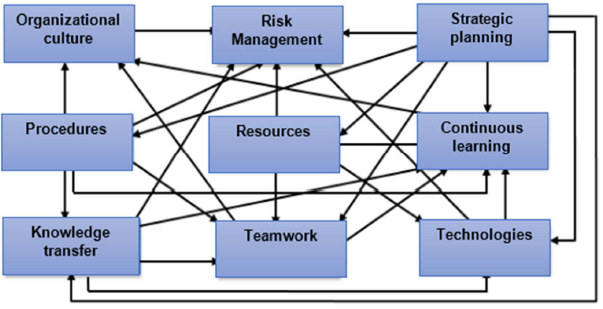
Figure Nº 2. Relationship diagram of the variables of Project Management and Knowledge Management
Source: Own Elaboration
Where:
Variable 1: Organizational Culture. (Items 1.1-1.6).
Variable 2: Risk Management. (Items 2.1-2.3).
Variable 3: Strategic Planning. (Items 3.1-3.3).
Variable 4: Procedures. (Items 4.1-4.2).
Variable 5: Resources. (Items 5.1-5.2).
Variable 6: Continuous Learning. (Items 6.1-6.2).
Variable 7: Knowledge Transfer. (Item 7.1).
Variable 8: Teamwork. (Items 8.1-8.3).
Variable 9: Technology. (Items 9.1-9.5).
From the analysis of the relationship diagram, the relationship matrix shown in Fig. 3 can be obtained:
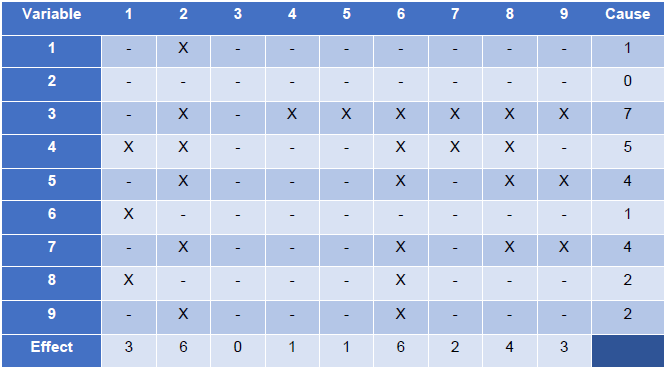
Figure Nº 3. Matrix of relations of the variables of Project Management and Knowledge Management
Source: Own Elaboration
Legend:
X: There is influence of one variable on the other.
-: There is no influence of one variable on the other.
Taking into account the results thrown by the activity diagram and the relationship matrix, the following can be proposed:
The variable that most influences the outcome of the others and is considered as a cause is Strategic Planning, followed by the variable Procedures.
The variables considered as effect are Continuous Learning and Risk Management.
Case study CUJAE
Next, the checklist will be applied to the entity under study CUJAE.
Stage 1: Selection of experts
The group of experts to participate in the application of the checklist taking into account that the NE was greater than or equal to 3, is as follows:
Table Nº3. Selection of Experts according to the NE
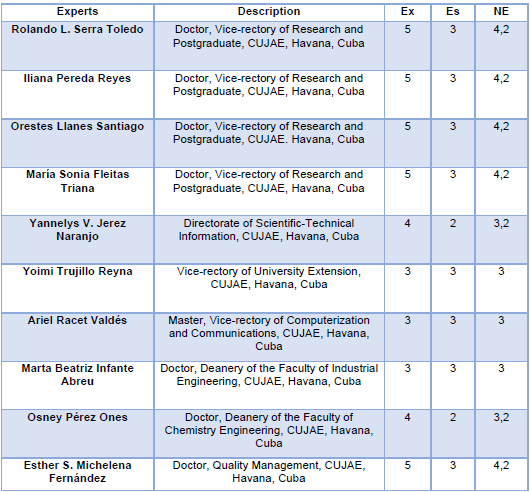
Source: Own Elaboration
Stage 2: Application and analysis of the checklist
According to the results obtained with the application of the checklist it was possible to carry out an analysis of the variables identified in this research, related to the project and knowledge management. The main results are shown below:
Variable: Organizational Culture
Regarding the Organizational Culture variable, it can be seen that Items 1.3 and 1.4 show a lower performance (See Fig. 4), so it is detected as main deficiencies that:
-There is a project culture, which is not enough for knowledge management.
-The knowledge base that the university has yet to contribute to the continuous improvement of the formulation and management of projects.
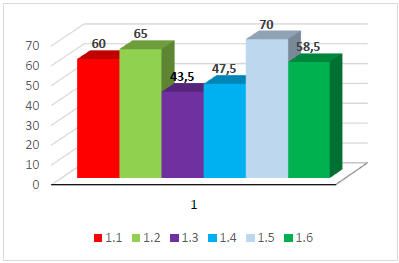
Figure Nº4. Behavior of the variable Organizational Culture
Source: Own elaboration
Variable: Risk Management
Analyzing the variable Risk Management, it is observed that all of its items have a lower performance (See Fig. 5), so that the following deficiencies were detected:
-The risks linked to project management are not identified, analyzed or controlled.
-The university risk action plan is not linked to the projects.
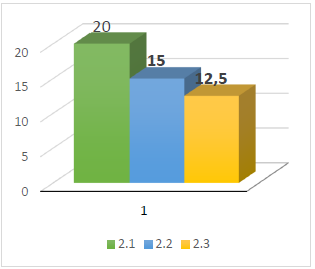
Figure Nº5. Behavior of the variable Risk Management
Source: Own Elaboration
Variable: Strategic Planning
Regarding the Strategic Planning variable, it can be seen that the item with the lowest performance is 3.3 (See Fig. 6), so the following is detected as the main deficiency:
*Organizational outreach strategies are not formulated and implemented for the development, acquisition and application of knowledge.
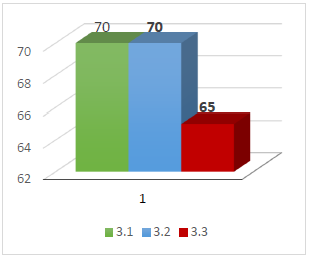
Figure Nº6. Behavior of the variable Strategic Planning
Source: Own Elaboration
Variable: Procedures
According to the analysis carried out, the variable Procedures, presents the most unfavorable behavior in item 4.1 (See Fig. 7), so that the following is detected as the main deficiency:
-The university does not have models or methodologies to manage both projects and knowledge.
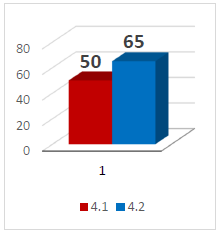
Figure Nº7. Behavior of the variable Procedures
Source: Own Elaboration
Variable: Resources
For the variable Resources, the item that presents the most unfavorable behavior is 5.1 (See Fig. 8), so the following is detected as the main deficiency:
-In the university, the organization and administration of resources is not enough to complete all project work within the scope, time and costs defined.
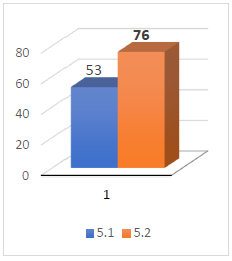
Figure Nº8. Behavior of the variable Resources
Source: Own Elaboration
Variable: Continuous Learning
Analyzing the Continuous Learning variable, it is observed that all of its items show unfavorable behavior (See Fig. 9), so the following deficiencies were detected:
-In the university, the activities that are carried out to collect intelligence and collective expertise are not enough to encourage innovation through continuous organizational learning.
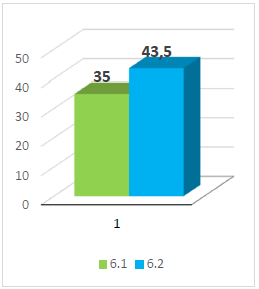
Figure Nº9. Behavior of the variable Continuous Learning
Source: Own Elaboration
Variable: Transfer of knowledge
The variable Transfer of knowledge is evaluated by only one item, which behaves unfavorably taking a value of 48. Therefore, it is identified as a deficiency that the knowledge dissemination is not enough in the university, for example, the lessons learned and practices; so that all its members can use knowledge in the context of their daily activities.
Variable: Team work
Regarding the variable Teamwork, it can be seen that Items 8.1 and 8.2 present the most unfavorable behaviors (See Fig. 10), so it is detected as main deficiencies that:
-In the university there is no working group with specialists linked to project management to support the work of the project teams.
-There is little relationship between the different departments or functional areas of the university that allow the development of projects to manage knowledge.
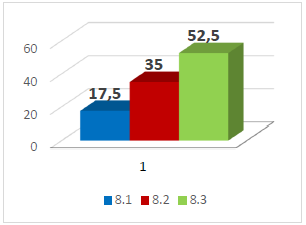
Figure Nº10. Behavior of the variable Teamwork
Source: Own elaboration
Variable: Technology
Regarding the variable Technology, it can be seen that Items 9.1, 9.2 and 9.5 present the most unfavorable behaviors (See Fig. 11), so it is detected as main deficiencies that:
-Not enough tools are used to organize and support project tasks.
-Not enough tools are used to manage knowledge in the university.
-Information services implanted in universities are not sufficient and do not have a well-established organization.
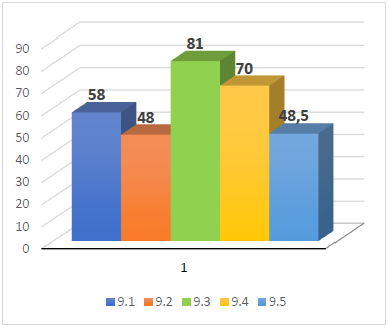
Figure Nº11. Behavior of the Technology variable
Source: Own Elaboration
Other deficiencies detected during the application of the checklist
During the application of the checklist, the experts raised other deficiencies that are not contemplated in the questions asked, which are shown below.
-Project management sites, Copernicus, Quorum and Codex; they do not contain the attached documents regarding the development of the projects.
-In the university information service implanted in the university, there is no service vocation.
Verification of the reliability of the Instrument
To check the reliability of the checklist applied, that is, the stability or consistency of the results obtained; Cronbach's Alpha was used, making use of the Microsoft Office Excel tool.
The formula used was the following:

Where:
K: The number of items.
ΣSi2: Sum of the Variances of the Items.
ST2: The variance of the sum of the items.
a: Alpha coefficient of Cronbach.
The result obtained was a Cronbach's Alpha equal to 0.83; result that is close to 1 and in turn greater than 0.7; so, it can be stated that the proposed questions fulfill the objective of their design.
Analysis of the variables on which the main actions should be directed.
In general, the analyzed variables are in an unfavorable situation for the university because there is more than 50% of the variables above 50, but they do not reach the value of 75, which represents an acceptable evaluation, although it is not the ideal On the other hand, it can be seen that the most critical variables are Risk Management (Variable 2), followed by Teamwork (Variable 8) and Continuous Learning (Variable 6) (See Fig. 12).
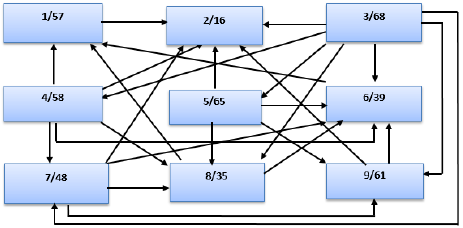
Figure Nº12. Diagram of Relations with the values obtained in the checklist
Source: Own Elaboration
Taking into account the relationships that exist between the main variables affected with the rest, it can be stated that:
-To improve the Risk Management variable, it is necessary to perform actions on variables 1, 3, 4, 5, 7 and 9, Organizational Culture, Strategic Planning and Procedures, Resources, Knowledge Transfer and Technology respectively, since these constitute the variables causes of Risk Management.
-In relation to the variable Teamwork, it is necessary to guide the improvement actions towards variables 3, 4, 5 and 7 (Strategic Planning, Procedures, Resources and Knowledge Transfer respectively), since these directly affect Teamwork.
-On the other hand, to improve the performance of the variable Continuous Learning, we must work on variables 3, 4, 5, 7, 8 and 9 (Strategic Planning, Procedures, Resources, Knowledge Transfer, Teamwork and Technology respectively).
Then, the variables were prioritized taking into account those that obtained results with lower performance in the application of the checklist and the cause-effect relationships obtained in the relationship diagram. The variable with the highest priority is Strategic Planning, as well as being the cause of the variable with the lowest performance, it is the most influential variable of all that affects Risk Management. Taking into account this analysis for the remaining variables, the defined order was as follows:
1.Strategic Planning.
2.Procedures.
3.Resources.
4.Knowledge Transfer.
5.Technology.
6.Organizational Culture.
7.Risk Management.
8.Teamwork.
9.Continuous learning.
Economic valuation and social contribution
The study was conducted by three specialists, who worked 40 hours a week for 15 weeks in total and the cost associated with this work is $ 15 / hour. Calculating the total cost, you get the following:
Total cost = 15sem * 40h / week * 15 $ / h * 3 specialists
Total cost = $ 27000
Therefore, if CUJAE had contracted this service, it would have incurred a cost of $ 27,000, that is, this money is saved since the study was carried out by specialists of said entity at no cost.
Likewise, as a social contribution of this work, it is stated that within the engineer's training at the university, knowledge was identified that has been lost and that is at risk of being lost due to the lack of specialists prepared to teach these subjects, which allows formulate and execute actions in time that assure the knowledge that already exists in the university, encouraging the development of new knowledge, as well as trying to rescue those that have already been lost.
CONCLUSION
A methodology was developed and partially implemented in order to evaluate project management and knowledge in the Technological University of Havana José Antonio Echeverría.
The use of a checklist and the relationship diagram constituted fundamental tools in the application of the methodology, facilitating the detection and analysis of deficiencies in the university related to the studies under study, which guarantees that later it can be established a plan of actions of improvements to eradicate the deficiencies identified during this investigation and thus achieve a better performance of the university.
REFERENCES
Please refer to articles in Spanish Bibliography.
BIBLIOGRAPHICAL ABSTRACT
Please refer to articles Spanish Biographical abstract.